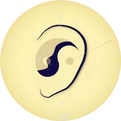Floating Pulse (Fu Mai, 主表)
1. The floating pulse is characterized by a strong sensation of the pulse when taken superficially, while the sensation diminishes when taken at the middle or deep levels, making the pulse feel as if it is floating.
2. The overall significance of the floating pulse is that the qi and blood are directed towards the body surface.
Fine Pulse (Xi Mai, 主血少)
The fine pulse is characterized by a narrow pulse vessel, felt as a very small pulse shape during palpation. It primarily indicates deficiency, with qi deficiency, blood deficiency, yin deficiency, and yang deficiency all potentially manifesting as a fine pulse. Clinically, blood deficiency and yin deficiency are more commonly observed. The fine nature of the pulse vessel is mainly due to the lack of substantial material filling the vessel.
Weak and Deficient Pulse (Xu, Ruo Mai)
Definition: The floating pulse indicates deficiency, while the deep pulse also indicates deficiency. Whether it is a weak pulse or a deficient pulse, the pulse beats are weak.
Deficient Pulse: The floating pulse is more pronounced but weak, while the deep pulse is significantly weak, sometimes even imperceptible to the fingers.
Deficiency and excess are antonyms; deficiency implies emptiness, falsehood, or lack. It appears superficially similar to normal conditions, but internally it is empty, merely a shell. The deficient pulse gives the illusion of a robust pulse when taken superficially, suggesting that the qi and blood are abundant, but upon slight pressure inward, it becomes evident that the internal organs lack sufficient qi and blood nourishment, representing a false exterior strength.
Weak Pulse: The floating pulse feels indistinct, while the deep pulse can be felt but is not resilient to pressure. 1. The pulse position is deep, 2. The pulse beats are weak, 3. The pulse body is thin, 4. The pulse vessel lacks tension.
Weakness and strength are antonyms, often implying softness, reduction, or frailty. It is immediately apparent that there is a deficiency, with no illusion involved. The weak pulse feels so powerless upon palpation, and the deep pulse only shows slight strength.
Both types of pulses are related to the weakness of the righteous qi. Whether it is a weak pulse or a deficient pulse, they are fundamentally linked to insufficient yang qi.
Qi deficiency is the primary mechanism leading to a weak pulse. Deficiencies in yin, yang, nutritive qi, defensive qi, body fluids, and blood often precede qi deficiency. Otherwise, the dosage of Huang Qi (Astragalus) in the Dang Gui Bu Xue Tang (Dang Gui Blood Supplement Decoction) would not be five times that of Dang Gui (Angelica Sinensis). This is because qi is the commander of blood; if blood is lost, both qi and blood are depleted, while qi can be quickly replenished, but blood cannot be rapidly increased. Qi deficiency can occur in the heart, spleen, and lung, and any organ can exhibit qi deficiency. The specific organ weakness should be assessed in conjunction with the six pulse positions and the characteristics of the pulse.
Causes of Qi and Blood Insufficiency
1. Excessive blood loss;
2. Weakness of the spleen and stomach function, leading to insufficient transformation.
Pulse Manifestations:
1. Blood deficiency will result in a fine pulse. (Fine pulse indicates blood deficiency)
2. Qi deficiency will result in a weak pulse, with weak pulse beats.
3. Insufficient yin blood leads to yang qi being unable to settle, resulting in a large deficient pulse.
4. Insufficient qi and blood fail to propel blood flow, resulting in a choppy pulse.
Tongue and Pulse: Pale tongue, thin white coating, fine weak or large weak pulse, accompanied by choppy characteristics, with a weak response upon deep palpation.
In clinical practice, when encountering such patients, one generally considers tonifying qi and blood, rarely considering issues with qi dynamics, and seldom using pulse characteristics or the characteristics of the pulse points. If material deficiencies are discovered, one should immediately consider whether it is primarily kidney essence or qi and blood. Commonly used formulas include Si Jun Zi Tang (Four Gentlemen Decoction), Si Wu Tang (Four Substance Decoction, also known as Shi Quan Da Bu Tang), Dang Gui Bu Xue Tang, Bu Zhong Yi Qi Tang (Tonify the Middle and Augment Qi Decoction), Xiao Jian Zhong Tang (Minor Construct the Middle Decoction), and Zhi Gan Cao Tang (Honey-Fried Licorice Decoction).

